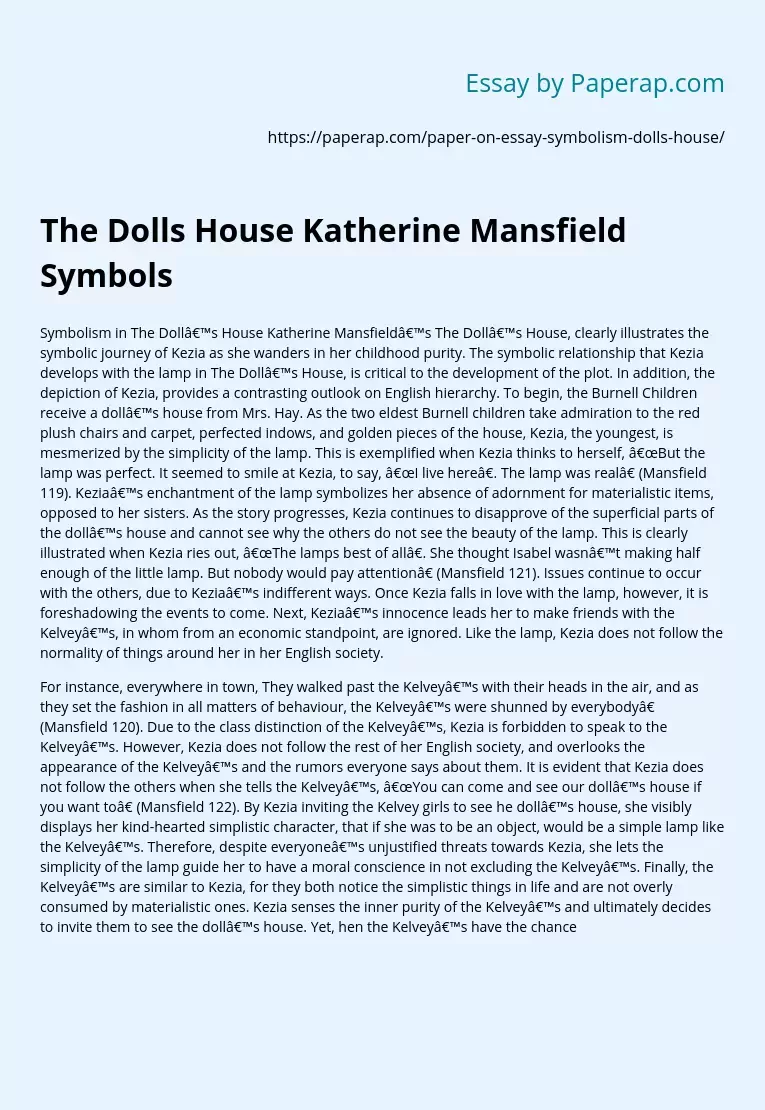The Dolls House Katherine Mansfield Symbols
Symbolism in The Doll’s House Katherine Mansfield’s The Doll’s House, clearly illustrates the symbolic journey of Kezia as she wanders in her childhood purity. The symbolic relationship that Kezia develops with the lamp in The Doll’s House, is critical to the development of the plot. In addition, the depiction of Kezia, provides a contrasting outlook on English hierarchy. To begin, the Burnell Children receive a doll’s house from Mrs. Hay. As the two eldest Burnell children take admiration to the red plush chairs and carpet, perfected indows, and golden pieces of the house, Kezia, the youngest, is mesmerized by the simplicity of the lamp.
This is exemplified when Kezia thinks to herself, “But the lamp was perfect. It seemed to smile at Kezia, to say, “I live here”. The lamp was real” (Mansfield 119). Kezia’s enchantment of the lamp symbolizes her absence of adornment for materialistic items, opposed to her sisters. As the story progresses, Kezia continues to disapprove of the superficial parts of the doll’s house and cannot see why the others do not see the beauty of the lamp. This is clearly illustrated when Kezia ries out, “The lamps best of all”. She thought Isabel wasn’t making half enough of the little lamp. But nobody would pay attention” (Mansfield 121). Issues continue to occur with the others, due to Kezia’s indifferent ways. Once Kezia falls in love with the lamp, however, it is foreshadowing the events to come. Next, Kezia’s innocence leads her to make friends with the Kelvey’s, in whom from an economic standpoint, are ignored.
Like the lamp, Kezia does not follow the normality of things around her in her English society.
For instance, everywhere in town, They walked past the Kelvey’s with their heads in the air, and as they set the fashion in all matters of behaviour, the Kelvey’s were shunned by everybody” (Mansfield 120). Due to the class distinction of the Kelvey’s, Kezia is forbidden to speak to the Kelvey’s. However, Kezia does not follow the rest of her English society, and overlooks the appearance of the Kelvey’s and the rumors everyone says about them. It is evident that Kezia does not follow the others when she tells the Kelvey’s, “You can come and see our doll’s house if you want to” (Mansfield 122). By Kezia inviting the Kelvey girls to see he doll’s house, she visibly displays her kind-hearted simplistic character, that if she was to be an object, would be a simple lamp like the Kelvey’s. Therefore, despite everyone’s unjustified threats towards Kezia, she lets the simplicity of the lamp guide her to have a moral conscience in not excluding the Kelvey’s. Finally, the Kelvey’s are similar to Kezia, for they both notice the simplistic things in life and are not overly consumed by materialistic ones. Kezia senses the inner purity of the Kelvey’s and ultimately decides to invite them to see the doll’s house. Yet, hen the Kelvey’s have the chance to catch a mere glimpse of the doll’s house, they are quickly “shooed out as if they were chickens” (Mansfield 123) by Kezia’s Aunt Beryl. In spite of that, the Kelvey’s are still able to see the lamp, the most important object in the entire doll’s house. The Kelvey’s, like Kezia, see beauty in the most unembellished things in life. When Else, one of the Kelvey sister’s says, “I seen the little lamp” (Mansfield 123), the symbolism of the lamp is established. At this point, Mansfield successfully conveys the overall message of the hope against discrimination.
The Dolls House Symbols
Thus, this hope, symbolized through the lamp, is a connection that brings Kezia closer to the Kelvey’s, in realizing their similar views. In conclusion, the symbolism of the lamp, that stems from Kezia and leads to the Kelvey’s, distinctly shows the divide and constant battle between rich and poor. Materialism in our world also shows how perplex it is for many humans to surpass the ever-constant greed man has towards material items. Seeing past the obvious beauties in life is a complex obstacle to conquer in The Doll’s House, that only Kezia and the Kelvey’s are able to do.
Both working together to fight this battle, therefore represent a lamp constantly searching for energy and hope to renew its light when it fades. In this case, the new light source was Kezia, who was seeking for an answer to help the Kelvey’s. Hence, the simplistic lamp represents the bonded connection that Kezia develops with the Kelvey’s, through the sightless faith of those around them, in the midst of their pure hearts. Works Cited Mansfield, Katherine. The Broadview Anthology of Short Fiction: The Doll’s House. Peterborough: Broadview Press, 2004. Print.
The Dolls House Katherine Mansfield Symbols. (2019, Dec 05). Retrieved from https://paperap.com/paper-on-essay-symbolism-dolls-house/

